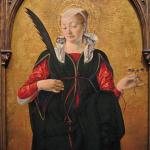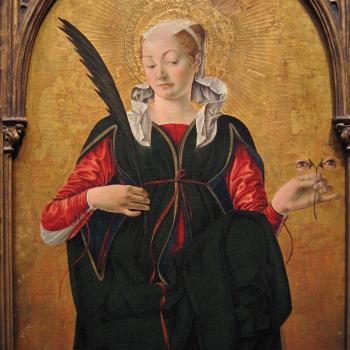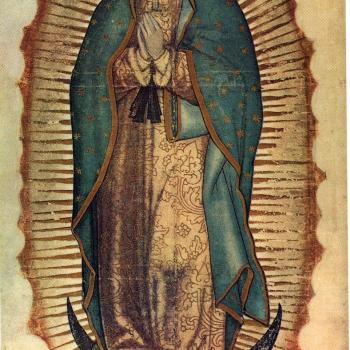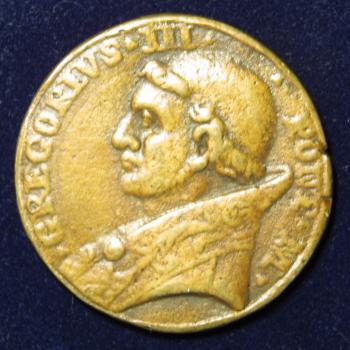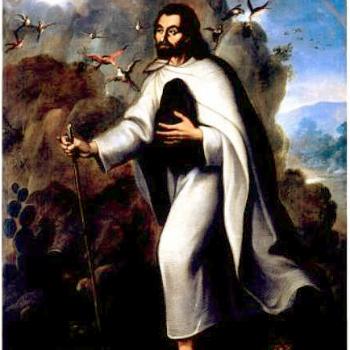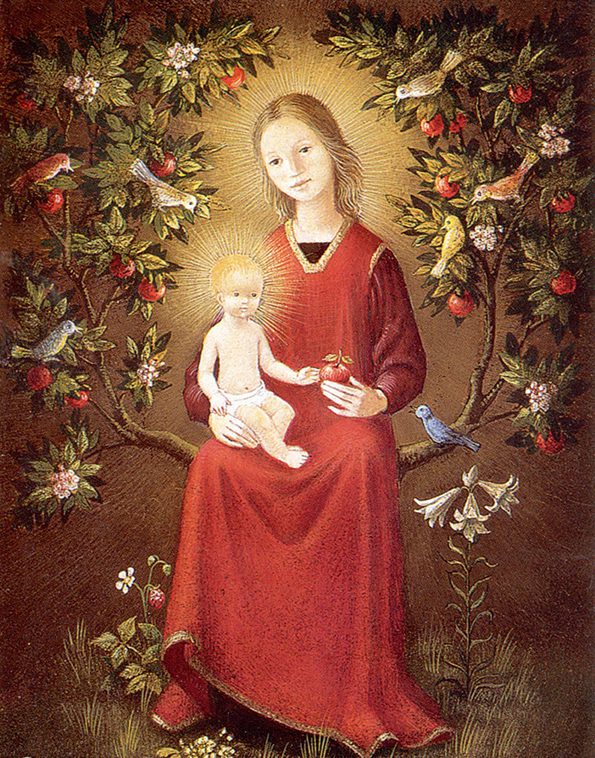
The Solemnity of Mary, Mother of God
Day Celebrated:
January 1, Holy Day of Obligation.
What Is the Feast About?
One of the most important dogmatic Marian teachings of our faith is that Mary is the Mother of God. This title of “Theotokos” or “God-Bearer” testifies to the fundamental reality of the Incarnation: the Person of the Son assumed to Himself a human nature; He is fully God and fully Man. The Catechism of the Catholic Church explains that:
Called in the Gospels “the mother of Jesus”, Mary is acclaimed by Elizabeth, at the prompting of the Spirit and even before the birth of her son, as “the mother of my Lord”. In fact, the One whom she conceived as man by the Holy Spirit, who truly became her Son according to the flesh, was none other than the Father’s eternal Son, the second person of the Holy Trinity. Hence the Church confesses that Mary is truly “Mother of God” (Theotokos).
Mary’s Divine motherhood follows from the fact that her son, Jesus, is truly God and truly Man, as the Gospel writers attest (c.f. Matthew 1:18-25, Luke 1:26-38, John 1: 1-18).
Nor were the earliest Church Fathers shy to recognize Mary as the Mother of God. St. Irenaeus, who lived during the second century, wrote in his work Against Heresies that the “Virgin Mary, being obedient to His word, received glad tidings that she should bear God” (5:19:1). Later, St. Ambrose invited his readers to consider the life of Mary by asking themselves “What is greater than the Mother of God? What is more glorious than she whom Glory Itself chose?” (Concerning Virgins II.ii.7) In his Letter to Cledonius the Priest, St. Gregory Nazianzen explicitly ties the truth of the hypostatic union of Christ’s divinity and humanity to the truth of Mary’s motherhood, writing “If anyone does not believe that Holy Mary is the Mother of God, he is severed from the Godhead.”
The Council of Ephesus in 431 A.D. explicitly takes up the question of Mary as the Theotokos. In this Council the Church addressed the Nestorian heresy by proclaiming that Mary’s Divine motherhood directly follows from the truth of the Incarnation. In short, the Nestorian heresy overemphasized the distinction between Christ’s Divine and Human Natures, leading those who held this position to claim that while Mary might be the “Christ-Bearer” in that she bore Christ with regards to his Humanity, she was not the “God-Bearer” or Mother of God. In refuting this claim, it is worth paying attention to three key proclamations the Council Fathers make:
We too ought to follow these words and these teachings and consider what is meant by saying that the Word from God took flesh and became man. For we do not say that the nature of the Word was changed and became flesh, nor that he was turned into a whole man made of body and soul. Rather do we claim that the Word in an unspeakable, inconceivable manner united to himself hypostatically flesh enlivened by a rational soul, and so became man and was called son of man, not by God’s will alone or good pleasure, nor by the assumption of a person alone. Rather did two different natures come together to form a unity, and from both arose one Christ, one Son. It was not as though the distinctness of the natures was destroyed by the union, but divinity and humanity together made perfect for us one Lord and one Christ, together marvelously and mysteriously combining to form a unity. So he who existed and was begotten of the Father before all ages is also said to have been begotten according to the flesh of a woman…The Word is said to have been begotten according to the flesh, because for us and for our salvation he united what was human to himself hypostatically and came forth from a woman.
Therefore, because the holy virgin bore in the flesh God who was united hypostatically with the flesh, for that reason we call her mother of God, not as though the nature of the Word had the beginning of its existence from the flesh (for “the Word was in the beginning and the Word was God and the Word was with God”, and he made the ages and is coeternal with the Father and craftsman of all things), but because, as we have said, he united to himself hypostatically the human and underwent a birth according to the flesh from her womb.
If anyone does not confess that Emmanuel is God in truth, and therefore that the holy virgin is the mother of God (for she bore in a fleshly way the Word of God become flesh), let him be anathema.
There are some today who deny that Mary is the Mother of God, for example our Protestant brothers and sisters, who do so out of fear that calling her mother of God preempts God the Father’s role as generator of the Son. It is helpful to note as the Council Fathers do, that Mary is not the one who generates the Son insofar as He is the Second Person of the Trinity. Rather, Mary’s Divine motherhood is in fact consequent on the Incarnation of the Son: because the Son, Who assumed to His Person a Human Nature such that He is fully God and fully Man, became flesh, the mother of Him according to the flesh is not some partial mother, but rather mother of the whole, who is God and Man. Thus, Mary is truly called the Mother of God, not as if she generated the Trinity, but because she gave birth to the Son Who is fully God and fully Man. This is why the Council Fathers are so insistent on Mary being understood as the Theotokos: because to deny her Divine motherhood is to deny the full reality of the Incarnation.
Once again we see the beauty of the image of Mary as the moon, for like the moon which reflects the light of the sun, so Mary constantly reflects and points back to her Son. When we honor Mary in feasts and titles, when we meditate on her role in salvation history, she constantly draws us beyond herself to her Son. To honor Mary does not take away from Christ, rather, it opens up a vista from which we can better understand the wondrous love which led Him to come and unite us to Himself.
When Did the Church Begin Celebrating It?
This feast is the oldest Marian feast in the Church, and has traditionally been celebrated within the octave of Christ’s birth. The Eastern Church, around 500 AD, began to celebrate a “Day of the Theotokos” around the time of Christmas. This celebration ultimately became a Marian feast celebrated on December 26th (in the Byzantine Church) and on January 16th (in the Coptic Church).
While the Roman Church had strongly emphasized marking the octave day of Christmas for Mary since ~600 A.D., it wasn’t until much later, in Portugal that an initiative began seeking to proclaim a specific feast of Mary’s Divine Maternity. This led to Pope Benedict XIV decreeing in 1751 that Mary’s Divine Maternity would be celebrated the first Sunday of May.
As the years passed, more countries and congregations sought and were granted approval to celebrate this feast in their own liturgical calendars. In 1914, the celebration of this feast had shifted to October 11, and in 1931 Mary’s Divine Maternity was declared a universal feast. Finally, the feast was moved back to the octave of Christmas thanks to the Second Vatican Council, and has been celebrated on January 1 since 1969. As Pope Paul VI wrote about the shift,
In the revised ordering of the Christmas period it seems to us that the attention of all should be directed towards the restored Solemnity of Mary the holy Mother of God. This celebration, placed on January 1 in conformity with the ancient indication of the liturgy of the City of Rome, is meant to commemorate the part played by Mary in this mystery of salvation. It is meant also to exalt the singular dignity which this mystery brings to the “holy Mother…through whom we were found worthy to receive the Author of life.”(17) It is likewise a fitting occasion for renewing adoration of the newborn Prince of Peace, for listening once more to the glad tidings of the angels (cf. Lk. 2:14), and for imploring from God, through the Queen of Peace, the supreme gift of peace. It is for this reason that, in the happy concurrence of the Octave of Christmas and the first day of the year, we have instituted the World Day of Peace, an occasion that is gaining increasing support and already bringing forth fruits of peace in the hearts of many.
Prayers for the Feast:
The Akathist Hymn to the Blessed Virgin Mary
It is becoming for you, O Mary, to be mindful of us, as you stand near Him who bestowed upon you all graces, for you are the Mother of God and our Queen. Come to our aid for the sake of the King, the Lord God and Master Who was born of you. For this reason you are called “full of grace.”
Be mindful of us, most holy Virgin, and bestow on us gifts from the riches of your graces, O Virgin, full of grace.
We honor you, O Mary,
Mother of God,
treasure of the universe,
inextinguishable flame,
crown of virginity,
scepter of the true faith,
indestructible temple,
tabernacle of the one whom
the world cannot contain,
and mother and virgin. …
In your virginal womb
you enclosed the immense and
incomprehensible One.
Through you the Trinity is glorified
and the cross is celebrated and adored
everywhere on earth.
Through you
the heavens exult with joy,
the angels and archangels are glad,
demons are put to flight,
the demon tempter is cast out of heaven,
and our fallen nature has again
been assumed into heaven. …
It is through you that the only-begotten Son of God,
who is the Light,
shone amid the nations
who were seated in darkness and the shadow of death.
What human voice can ever worthily celebrate
the ineffable greatness of Mary?
She is mother and virgin
at the same time.
Through her
peace has been restored to the world.
What peace?
Our Lord Jesus Christ,
whom Mary has brought forth!
Further Reading:
- Theotokos: Woman, Mother, Disciple- A Catechesis on Mary, Mother of God by Pope St. John Paul II
- The World’s First Love: Mary the Mother of God by Fulton Sheen
- Theotokos: A Theological Encyclopedia of the Blessed Virgin Mary by Fr. Michael O’Carroll, C.S.Sp.
- Rethinking Mary in the New Testament: What the Bible Tells Us about the Mother of the Messiah by Edward Sri
- Hail, Holy Queen by Scott Hahn
- Praying With Mary: An English-Latin Edition
- The Complete Ante-Nicene & Nicene and Post-Nicene Church Fathers Collection
- Canons of the Ecumenical Council of Ephesus; 431 AD
Resources:
- https://udayton.edu/imri/mary/archive.php?format=html&tags=Doctrine,%20Dogma,%20Theology%20and%20Tradition|
- https://udayton.edu/imri/mary/s/solemnity-of-marys-maternity-origins.php
- Mary+as+Mother+of+God%2FTheotokos
- http://www.newadvent.org/fathers/index.html
- http://www.newadvent.org/cathen/15464b.htm
- https://www.ewtn.com/library/councils/ephesus.htm
- https://www.catholicnewsagency.com/resources/mary/general-information/the-four-marian-dogmas
- https://www.osv.com/OSVNewsweekly/Story/TabId/2672/ArtMID/13567/ArticleID/6199/Theotokos.aspx

